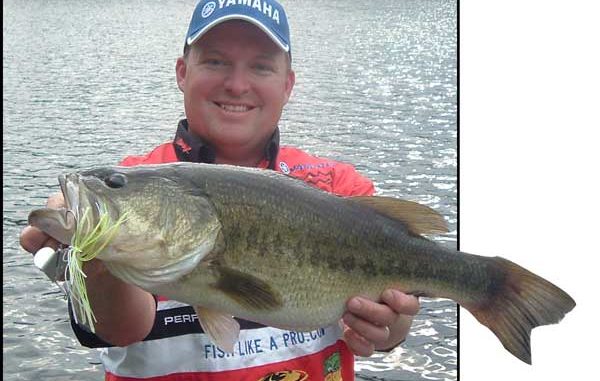
Anglers have so many choices in fishing lines these days it can be confusing to figure out just the right one for the task at hand. With monofilament, copolymers, fluorocarbon, braids and others, choosing can be difficult. Each type of line has advantages and disadvantages. Knowing the strong and weak points of various types of line will help you catch more fish.
Monofilament line, often referred to as “mono,” is the most-used and most-common line on the market. Easy to cast and manage, mono also is the least-frustrating line to use.
Manufacturers make different colors and breaking strengths of mono. Ten years ago I used mono exclusively; now I use it less than 5 percent of the time for bass fishing.
Monofilament lines come in different formulations, but for the most part, they have a lot of stretch when compared to other lines. This stretch can be a major advantage or disadvantage, depending on numerous factors.
With the stretch comes loss of hook-setting power but a gain in fish fighting ability. If tied to a lure with treble hooks, mono may help anglers keep a fish hooked when it makes a last -second dive to escape at the boat because of its stretch.
But with stretchy line, anglers also may not get a good hookset, causing them to lose fish.
My recommendation for mono is to use lighter wire hooks that are ultra sharp and stiffer rods to ensure you get a good hookset. I use mono in some situations for topwater because it floats (or nearly floats), depending on water temperature and line formulation.
I consider using mono as well for some situations with a spinning reel because it’s so easy to handle.
Mono is the least-expensive option and suited for all-around fishing situations.
But fluorocarbon line is my favorite.
I’ve been using fluorocarbond since 1999, and I’m extremely confident using it, today fishing with this line about 90 percent of the time.
The benefits are incredible — low stretch, high sensitivity, nearly invisible underwater, high abrasion resistance and high knot and shock strength.
But fluorocarbon has two major drawbacks — it’s harder to manage and is expensive.
Most fluorocarbons are going to cost at least $15 to fill a reel. It lasts longer than mono because it doesn’t absorb water, but you can ruin a spool easer with one bad backlash.
Like all lines, some bad brands of fluorocarbons are out there. If you try one type of fluorocarbon and don’t like it, try another brand.
I recommend fluorocarbon only to experienced fishermen for these reasons. It’s such a huge advantage for me to use this line that I accept the higher price and harder manageability.
But anglers should be aware some fluorocarbon brands handle better than others.
Overall, lines seem to be have “give-and-take” properties. If they’re easy to manage, they’re usually less abrasion resistant. Fluorocarbon sinks, so you can’t use it with most topwater lures, other than buzzbaits, because it’ll pull your lure underneath the surface and spoil the action.
But fluorocarbon’s lower stretch factor makes it possible to get positive hooksets with lures that have big hooks, such as jigs, spinnerbaits and worms.
Copolymer line may be a good alternative for those looking for a little of the benefits of fluoros and monos. These lines generally have a little less stretch and more abrasion resistance than mono. Still easy to manage, copolymers are a good alternative for anglers who don’t like fluorocarbons.
Braided lines are loved or hated by most fishermen.
Extremely strong for its diameter and possessing no stretch characteristics are the strong points of braid.
Many fishermen use braid all the time and love it.
I use braid during three situations — frog fishing, flipping matted cover with big weights and occasionally skipping lures underneath cover with spinning gear.
In my mind, braids have many disadvantages but still must be considered for their enormous power and strength.
Braids also are opaque, so they’re extremely visible underwater. Are fish smart enough to tell? I don’t know, but being able to see braided line makes me less confident.
However, when using it for flipping mats or other heavy cover, fish may not be able to see it as clearly as in open water.
Anglers also have to be careful with knots to tie braid as they have a tendency to slip if tied incorrectly. Many fishermen even put a drop of glue on braided-line knots to make sure they don’t unravel.
The lack of stretch in braided line also may result in too powerful of a hookset and cause a big hole in the fish’s mouth and a good opportunity for a bass to throw a hook.
You may need to compromise with a lighter action rod or a lighter hookset to avoid ripping the hook out of bass mouths if you’re using braid. You also have to be careful fishing it near rocks because rocks will slice braid like a knife.
With all the line choices on the market, it’s hard to choose which to buy.
My advice is to try them all and decide which lines are the best fit for your style of fishing.
Dustin Wilks is a 31-year-old professional bass angler and Raleigh native now living in Rocky Mount. He has qualified for the Bassmaster Classic four times and operates Fish Like a Pro Fishing Lessons (252-883-6749, www.fishlikeapro.com ). His sponsors include Assassinator Spinnerbaits, Chatterbuzz, Skeeter Boats, Yamaha, Daiwa, Keelshield and Culprit.



Be the first to comment